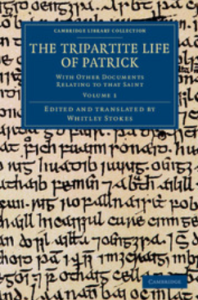The early history of the parish is associated with the Christian mission of St Patrick who travelled through the area in the fifth century. Much of this association is based on information in The Tripartite Life of St Patrick, written sometime between the ninth and twelfth centuries, scholars do not agree on the date.
John O’Donovan is well known for his association with the first Ordnance Survey of Ireland. He worked for the Topographical Department of the first Ordnance Survey from 1830 to 1842 researching the history of place names and trying to establish their origin. He writes in one of his Ordnance Survey letters that the Tripartite Life records Patrick proceeded from near Clogher to the territory of Hua-Meith-Tire where he erected a church at a place called Teagh-Tallain now Tehallan in the barony of Monaghan and converted Eugenius the son of Brian, the Dynast of the district. (From Clones, 29 May 1835).
In another letter O’Donovan writes Archdall was not able to discover that the Tech Tellain of the Tripartite Life was the present Tehallen, but there can be no doubt about it as it is placed in regione Hy Methiorum, which was a large district in this county north of the territory called Feranmhagh and originally comprising the barony of Monaghan as well as Cre-Mourne. (From Monaghan, 9 May 1835).
O’Donovan is referring here to Mervyn Archdall, a late eighteenth century Irish antiquary.

The Tripartite life of Patrick
The Tripartite Life also records that Patrick went to the district of Hui Meith tire in Tigh Thalan. Patrick left bishop Cilline there, and aged folk of his household besides and relics of ancients which he had brought with him overseas from the east.
This is a significant quote as it mentions Cilline at Tyholland and also that St Patrick came across the sea from the east, presumably Wales.
Another Patrician document, known as the Leabhar Breac supports the statement that St Patrick left a community of his followers at Tyholland. It says that Patrick went ‘into the territory of Uí Méith in Mennait Tíre, and he visited not Armagh at that season and holy elders of his household he left at Tigh Thalan’.
Bishop Joseph Duffy writes that these documents show that Tyholland had a high rating among Patrician churches, second only to Armagh itself and that the author of the Leabhar Breac accorded Tyholland the privilege of a visit from St Patrick in preference to Armagh. (Monaghan History and Society, ch. 7).
Two contributors to the National Schools project in the 1930s associate the site of this first church with land held by the McArdles. A story was told of strange things happening when St Patrick was building the church at Tyholland. Every morning for three days the previous day’s work was knocked down so during the fourth night St Patrick stayed up to see what was happening. ‘During the night he saw a long black snack coming up from McArdle’s bog’. St Patrick cut the head off the snake which then disappeared into the bog. Mrs Murdock of Skinnagin, aged 78, was one of the sources for this story in the 1930s. She also said that the ‘church was built where McArdles barn now stands’. (Duchas, Schools Collection, Leitrim School, Vol 951, page 203).
A baptism of a McArdle is recorded in Tyholland Church in 1814 and there was a family of Ardills living in Templetate in the 1840s and 1850s. The father Lancelot was a servant in the glebe house or rectory. The family are also recorded in the 1901 and 1911 censuses, including Lancelot or Lanty and Jack Storey writes that ‘the land at Templetate is still known as Lanty’s’.
As recorded in the Tripartite Life of St Patrick the Church at Tyholland was favoured with a number of relics. Bishop Duffy writes that relics were a token of the highest honour and importance for Church communities throughout medieval Europe and they were treasured and protected with the greatest reverence and care. (Monaghan History and Society).
One of the relics we know of in this area was the Bachall Damhnait, the pilgrim’s staff of St Davnet, an instrument on which to swear and make bargains. It was held for many years by the Lamb or Ó Luain family of Tedavnet. Jack Storey also mentions this relic which he says was kept at Knockboy in a long box trunk containing a crucifix and some bones. Evelyn Shirley also refers to this box at Knockboy in his history of the county.
An anecdote relating to St Patrick appeared in a newspaper, The Monaghan Angus, 20 March 1954. It recorded a tradition that thieves stole one of the two goats that belonged to St Patrick while he was in the area and ate it. When one of the thieves was going to swear that he didn’t steal it, the goat bleated from inside him and St Patrick declared that goats would follow him and his family for ever. The descendants of these thieves were believed to have goatee beards.